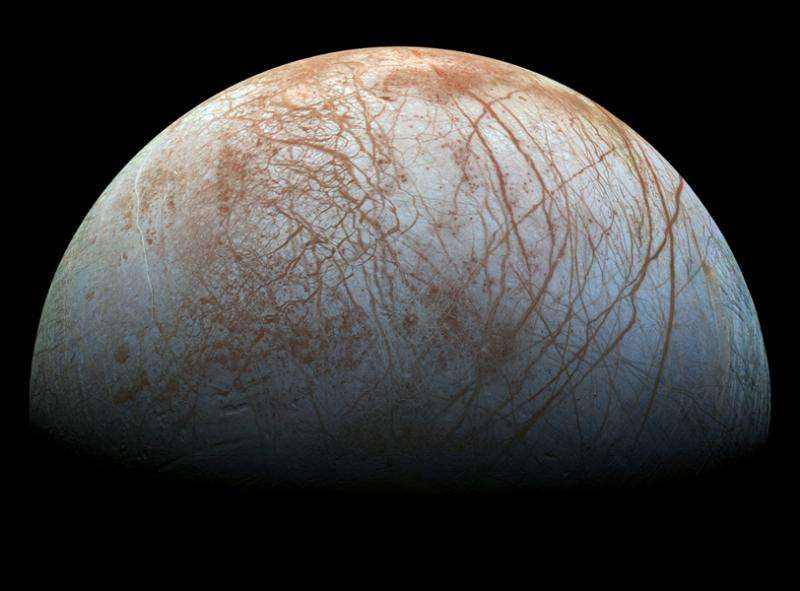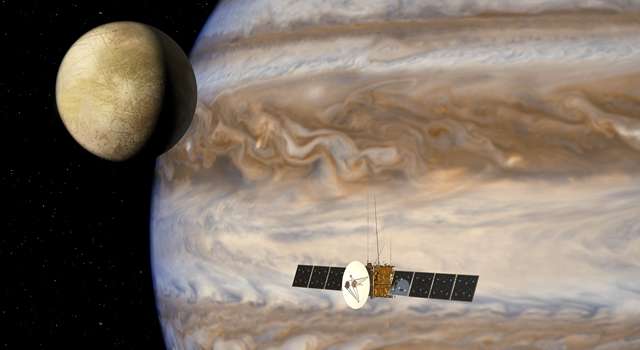Advances in robots needed to explore icy moons

In December 2013, researchers using the Hubble Space Telescope announced they had found evidence of a water plume emanating from Europa's surface.
The finding excited astrobiologists because this moon of Jupiter is widely known to have ice covering its surface. If water is escaping from the ice, that implies that there could be a way for microbial life beneath to receive energy.
The plume has not been spotted since, and scientists are still trying to figure out why this is the case. In the meantime, the possibility of plumes more generally presents an intriguing question about how best to explore them. After all, even if plumes are never spotted near Europa again, they are known to be regular occurrences on Saturn's moon, Enceladus.
"The idea is that we can develop a sort of Swiss army knife, or instruments and exploration strategies for the icy moons, and the plumes of the icy moons," said Nathalie Cabrol, a research scientist at SETI Institute, who recently led a presentation called "Europa and beyond: Adaptive robotic exploration of planetary plumes."
The abstract was submitted in February at a workshop entitled, "Workshop on the Potential for Finding Life in a Europa Plume," at the NASA Ames Research Center in Mountain View, California and co-hosted by the NASA Astrobiology Institute and the Solar System Exploration Research Virtual Institute.
Communications delays
NASA is experienced at sending spacecraft to planets far from Earth. For example, the Cassini mission, a joint project with the European Space Agency, is currently imaging Saturn and its moons. The mission has been at Saturn since 2004 and is expected to work there until 2017.

Traditionally, however, spacecraft in the Outer Solar System are unable to react to events in real time. Because they are so far away from Earth, the radio signal takes hours to reach the spacecraft and hours more to get home. This means the spacecraft do their work through long pre-programmed computer routines that are directed by ground teams on Earth.
This is even an issue on Mars, which is relatively close to our planet, with at most a 40-minute lag time between sending receiving signals, Cabrol points out.
"It's not practical to deal with it," she said. "The rover is spending a lot of time sitting on the surface doing nothing, which is an unproductive way of using mission time."
The solution is to use more intelligent robots that can adapt to the environment around them, she said. This has already been tested out in challenging climates here on Earth, such as in the Andes. These robots accumulate enough data to learn what is normal and what is not normal in an environment. Also, they have programs on board to let them know what are observational priorities of the mission.
"They stay alert to what is happening around them, and they have templates on how to operate if something important is happening," Cabrol said.
Networked intelligence

Cabrol has spent the past couple of decades working on adaptive robots in several harsh environments, ranging from the Atacama Desert in Chile to mountainous areas.
She recalled a project she is working on that involves a robotic lake explorer in Chile, which is a testbed for technologies to use on the moon Titan. The saturnian moon is considered very swampy and could contain molecules that are a precursor to life.
The robot was programmed to alert the science team if events important to the mission science objectives were occurring between planned activities. Because the test took place on Earth, the alert was sent by the robot via email. The message contained a panorama as well as physicochemical data from the air and water column. One day, as a storm occurred over the lake, Cabrol received an e-mail alert from the robot.
"I opened the window and there was a gigapan panorama showing the Lake Lander buried in the snow," she said with a laugh. "You were right. Good job."
To do serious exploration of a planet or moon, she added, it is a good idea to send a network of robots that would have distributed intelligence They could communicate with each other from the surface and from orbit to gather a complete picture of the area and make missions substantially more productive.
Provided by Astrobio.net




















